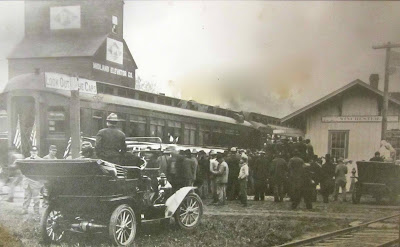Compiled by Karen M. Heady
In June of 1854, a man named William Gardiner was heading
west on the Military Road from Fort Leavenworth to Fort Riley with homesteading
in mind. About a day’s journey (18 miles) out of Leavenworth, he came to a
place where he was at once impressed. Nearby was a very fine spring, a natural
stopping place for weary, thirsty travelers.
Mr. Gardiner staked two claims, one on a river (Walnut Creek
— marked in Section One on the map with a “dwelling,” which was quite probably
the log cabin he built for his family in 1855); the other claim was right near
the road, a quarter section he planted, which yielded an excellent crop of
corn. This good farming, in all likelihood, drew other farmers to the area,
creating a small settlement, which in turn drew “city” businesses.
Mr. Gardiner sold his claim nearer the Military Road to
Joseph Best. Mr. Best built two log cabins that were connected to form a hotel.
This first business flourished with both military and civilian travelers. This
drew more people to the area to settle.
In 1857, the settlers decided to choose a site for their
town. They chose a site near a spring (about 1 ½ miles further south along the
Military Road than the present Winchester) and called it Savannah. However, the
oldest settler wished to have a different location named Winchester, after his
old home town in Virginia. They agreed to go along with him. So the present
town of Winchester is where it is because of the oldest settler of that year —
Alvin Best.
For water, the settlers hauled tubs on buckboards to the
Walnut Creek Spring. It was said in 1938 that, “Men may come and men may go,
but the spring will flow forever.” So far, it is true. In 1981, it was still
one of Winchester’s main sources of water.
There is still only a small portion of the Military Road
intact in Winchester today. It is the diagonal road just south of the Jefferson
County North School Complex. My guess is that the settlers phased out the
“road” soon after the government land survey “squared off” the land. The main
businesses had been located on Main Street. As fires destroyed the frame
structures and businesses prospered, many relocated into more permanent
buildings along Third Street and Winchester Street, putting them closer to the
railroad.
The railroad came through in 1872, running east and west
between Delaware Street and Grasshopper Street. This made Winchester a thriving
community, especially in the first quarter of the 1900s. When the railroad left
in the 1930s, the town’s population started slipping. This was shortly after
the depression years.
Sources: Kansas Historical Society Library and Maps Section
in Topeka
Jefferson County Department of Engineers in Oskaloosa
Finley Abstract Office in Oskaloosa
The old Winchester Railroad Station and the Midland Elevator
Co.
These buildings as well as the railroad itself, have been gone for many years. The occasion pictured above by Charles Forsyth was the arrival of the Leavenworth “Booster” train.
The following short notation is found in the Winchester Star, 21 October 1910 (page 4) — “The Leavenworth ‘Booster’ train made up of 110 passengers, representing different business firms of Leavenworth, arrived in Winchester on schedule time Wednesday morning. The band played and the passengers got busy and made the acquaintance of a number of our people. They left numerous souvenirs with our people.”
These buildings as well as the railroad itself, have been gone for many years. The occasion pictured above by Charles Forsyth was the arrival of the Leavenworth “Booster” train.
The following short notation is found in the Winchester Star, 21 October 1910 (page 4) — “The Leavenworth ‘Booster’ train made up of 110 passengers, representing different business firms of Leavenworth, arrived in Winchester on schedule time Wednesday morning. The band played and the passengers got busy and made the acquaintance of a number of our people. They left numerous souvenirs with our people.”
In this same issue of the Star (page 1) is the
following advertisement: “Chas. Forsyth, Photographer; View, Portraits; Amatur Work and Supplies; Permanency
Guaranteed; Phone No. 29.” Mr. Forsyth changed his ad for the next week’s paper to read: “Having secured
the agency for the well known, popular Seneca Cameras, for both plates and film
packs, I can now supply you with anything in that line. Call or write for
latest illustrated catalogue and prices; Chas. Forsyth, Photographer,
Winchester, Phone No. 29.”
This story appeared in “Yesteryears” in April 1981.




No comments:
Post a Comment